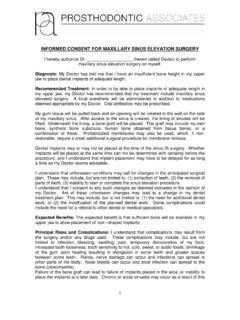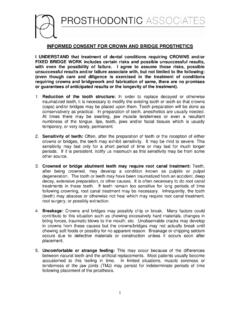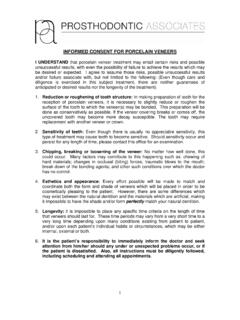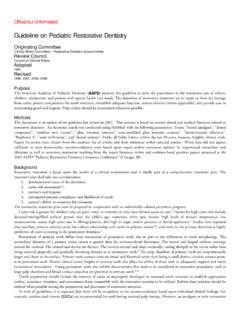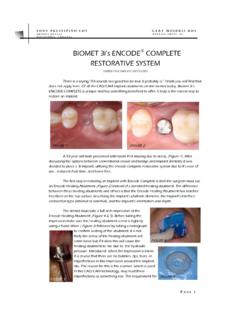Transcription of Extracoronal Splinting - Aesthetic & Cosmetic Dentistry
1 Izchak Barzilay, DDS, Cert. Prostho.,MS. A b s r act Splinting teeth to each other allows weakened teeth to be supported by neighbouring teeth, although the procedure can make oral hygiene procedures difficult. Severalmethods for Splinting teeth, both Extracoronal and intracoronal, as well as the materials commonly used for Splinting , are described and illustrated. Two case reports are used to demon';-tratethe situations in which Splinting might be appropriate. MeSH Key Words: dental bonding; periodontal splints; tooth mobilityltherapy 1:1J Can Dent Assoc 2000; 66:440-3. This alticle has been peer reviewed.
2 S plinting teeth to each other allows weakened teeth to Farmingdale,NY), PanaviaO. Morita USA Inc., Irvine,)CA) or gain support from neighbouring ones. When used to All Bond (Bisco Inc., Schaumburg,IL). This type of splint has connect periodontally compromised teeth, Splinting can greater inherent strength than a composite-resinsplint created increase patient comfort during chewing. Connecting intraorally. Extra features such as grooves, pins and parallel multiple teeth also increasessupport when the teeth are used preparationsincreasethe retentive capacityof thesesplints. as abutments for a precision attached partial denture.
3 Newly developedlaboratory-curedcomposite resinssuch as However, Splinting makes oral hygiene procedures difficult. DiamondCrown (Biodent Inc., Mont-Saint-Hilaire, QC) claim Therefore, to ensure the longevity of the connected teeth, improved diametric tensile strength and bonding capabilities. special attention must be given to instructing the patient Thesematerialsmay be consideredfor usein extracoronalappli- about enhanced measuresfor oral hygiene after placement of cations (Figs. 2-4). No long-term clinical data are availablefor the prosthesis. thesematerials;however,they seempromising at this time.
4 Severalmethods, both Extracoronal and intracoronal, are availableto splint teeth together. lntracoronal Splinting Intracoronal methods are also available. Composite-resin ExtracoronalSplinting restorations can be placed in adjoining teeth and cured to The simplestway to connect teeth to eachother is the classic eliminate any interproximal restorationscan bonding method. The enamel surface of the tooth is etched, be further reinforced with metal wires, glass-reinforcedfibres most commonly with a 37% solution of phosphoric acid. or pins (Fig. 5). If restoration of the mouth includes crowns, Composite resin can then be bonded to the etched surfaceand the crowns can be splinted to each other by solder joints or usedto rigidly connect the teeth to eachother.
5 The composite- precision attachments. The use of attachments affords the resin splint can be strengthenedby adding fibres to the splint or practitioner the easeof preparing nonparallel abutments yet by using a fibre meshwork ( , Ribbond, Ribbond Inc., achievesa splinted result. Seattle,WA) to reinforce the material. Extracoronalresin-bondedretainers,which can be fabricated Case Reports in the dental laboratory, serveto strengthenthe overall bonded This paperpresentstwo clinical casesin which Splinting splints are usually castfrom metals, usually non- wasneededaftercrownshad alreadybeenplaced. noble alloys that can be electrolytically or chemically etched (Fig.)
6 1). Recentinnovations in materialsallow theseframeworks Case}. to be air abradedand then cementedin placewith an adhesive A 60-year-old woman was involved in a motor vehicle resin cement, such ~ Metabond C&B (Parkell Inc., accident. Prosthetic reconstruction involved placing crowns on 440 September2000, Vol. 66, journal of the Canadian Dental Association Figure 1: Metal splint created from non-noble metal has been bonded Figure2: Mobile teeth have beenpreparedwith cingulumreststo with Metabond C&B cement and is being used to securemobile teeth. help supportan extracoronalcomposite-resin-based splint.
7 Figure 3: A composite-resin-based splint has been fabricated from Figure 4: DiamondCrown splint has been cemented {bonded} under DiamondCrown material. Once polished, it will be ready for rubber dam isolation. This material exhibits superior flexural strength cementation. and may be useful in Extracoronal splints. first and second molars opened. Food was becoming trapped in this area, and inflammation ensued. In an attempt to remedy the problem, the crown on the second molar was replaced with a new crown, which had mesial contact. Approximately one year later the contact opened once again. Occlusion was deemed adequate; therefore, to close the contact area, Splinting the 2 teeth together was attempted.
8 The crowns on teeth 26 and 27 consistedof porcelain fused to metal, so Splinting would involve bonding to metal as well as porcelain. Back-to-back inlays with dovetail designs were prepared (MO in tooth 27 and DO in tooth 26). A polyether impression was made (Impregum, ESPE America Inc., Norristown, PA), and an epoxy die was poured. An inlay based Figure 5: Metal-based wire splint (Splint-Lock System, Whaledent on this die was waxed to extend from tooth 26 to tooth 27, Inc., New York, NY) is secured to mobile teeth with individual metal- acrossthe interproximal area. The wax pattern was invested based pins.
9 The metal splint is then covered and bonded to the mobile and cast in a nickel-chrome-beryllium alloy (Pisces, teeth with composite resin. IvoclarlWilliams USA, Amherst, NY) (Fig. 6). The inlay was air abraded (microetched) with 25-~m aluminum oxide and most of the remaining teeth, as well as increasing support in thermochemically etched (Assure-etch,IvoclarlWilliams USA, the anterior region of the mouth with osseointegrated Amherst, NY) in preparation for cementation. implants. Approximately one year after conclusion of the Cementation involved first treating the crowns to render implant treatment, the contact region between the upper left them amenableto bonding.
10 After isolation with a rubber dam, Journal of the Canadian Dental Association September2000, Vol. 66, Figure 6: Inlay made from non-noble metal has a handle and has been Figure7: The inlay has been cemented with Metabond C&B. The cast, fit to the master cast and etched; once the inlay is cemented in inlay remained secure after 4 years of service. place, the handle is sectioned and removed. (porcelain fused to metal) was well made and had no clinical deficiency, a conservative approach to the open contact was needed. It was decided to splint the 2 existing restorations across the contact area with a cast restoration.
